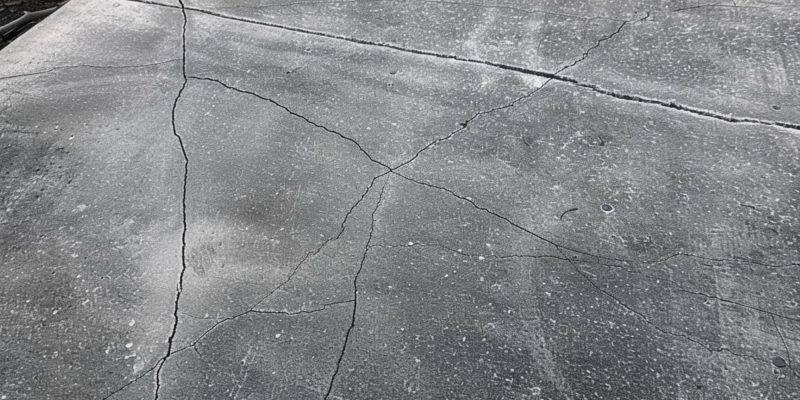Noticed some unwelcome guests on your concrete patio? Yep, we’re talking about cracks. But don’t fret! This guide’s got your back. We’ll walk you through spotting different crack types, fixing ’em up nice and good, and even stopping new ones from popping up. Ready to give your patio the love it deserves? Let’s dive in!
Understanding Concrete Cracks
Cracks in your concrete patio aren’t just eyesores; they’re clues about what’s happening underneath. Let’s get to know these uninvited visitors a bit better, shall we?
Types of Concrete Cracks
Hairline Cracks: These are the skinny ones, barely noticeable but there. They’re like the tiny scratches on your phone screen – not a big deal but can lead to bigger issues if ignored.
Shrinkage Cracks: Ever noticed cracks that look like a spider’s web? That’s them. Concrete can shrink as it dries, leaving these patterns behind. They’re mostly harmless but can let water sneak in.
Structural Cracks: Now, these are the troublemakers. If you see cracks wider than a credit card, it’s a sign something serious is going on. They mean your patio might be shifting or settling more than it should.
Why Do Cracks Happen?
Think of your concrete patio like a cookie. When it bakes (or cures, in concrete speak), it can crack if the mix isn’t just right, or if the weather messes with it. Sometimes, the ground underneath moves or settles, and your patio goes along for the ride, which can also cause cracks.
NOTE
Knowing what type of crack you’re dealing with helps you figure out the best way to fix it.
Preparing for Repair
Before you jump into battle against those patio cracks, let’s gear up. Fixing cracks is like going on a treasure hunt; you need the right map and tools to find the treasure—aka a smooth, crack-free patio.
Assessing the Damage
Take a good look at your patio. Are the cracks thin as hair or wide enough to see from space? Knowing what you’re up against helps you pick the right tools and materials.
Gathering Materials and Tools
For most patio heroes, you’ll need:
- A stiff brush or a vacuum to clean out the cracks.
- Concrete crack filler or sealant for those hairline and shrinkage cracks.
- A trowel or putty knife to apply the filler.
- For the big, bad structural cracks, epoxy or a concrete patching compound might be on your list.
Having these tools at the ready will make the repair process smoother and quicker.
Repairing Different Types of Cracks
Now that we’ve prepped, it’s time to tackle those cracks head-on. Whether it’s a tiny hairline or a gaping structural crack, there’s a way to mend your patio back to its former glory.
Hairline Cracks
These little nuisances might not seem like much, but they’re the gateway for water to seep in and cause bigger problems. Here’s how to shut the door on them:
- Cleaning: Grab a stiff brush, or for a deeper clean, use a vacuum with a nozzle attachment to ensure all debris, dirt, and tiny insects are removed from the crack. This step is crucial for the sealant to adhere properly.
- Sealing: Select a high-quality concrete crack sealant designed for hairline fractures. These sealants are usually silicone-based, offering flexibility and waterproofing. Cut the sealant’s nozzle at an angle for better control and squeeze it into the crack, ensuring it’s completely filled. If you’re seeking a neater finish or dealing with slightly wider hairline cracks, use a putty knife or a trowel to press the sealant into the crack and smooth the surface. This not only seals the crack but also blends the repair into the surrounding area.
Shrinkage Cracks
Shrinkage cracks, resembling a spider web, are common and generally not a sign of structural issues. However, they can mar the look of your patio and allow moisture ingress.
- Prepare the Crack: As with hairline cracks, start with a thorough cleaning. A leaf blower can be effective here to remove loose debris and dust from multiple cracks quickly.
- Fill ‘Em Up: Opt for a polyurethane or acrylic-based concrete filler for its elasticity, which accommodates concrete’s slight movements without cracking. These fillers come in tubes for easy application. Gently squeeze the filler across the cracks, ensuring deep penetration. Use a trowel or putty knife to spread the filler, creating a smooth, level surface with the rest of the patio. Allow the filler to dry as recommended by the manufacturer before walking on the surface.
Structural Cracks
When it comes to the big ones, you might need to roll up your sleeves a bit more. If you’re unsure about tackling these, consulting a pro isn’t a bad idea. But if you’re feeling brave, here’s what you can do:
- Clean the Area: Use a wire brush to aggressively clean inside the crack, removing all loose concrete, dirt, and debris. For deeper cleaning, consider using a leaf blower or a vacuum.
- Epoxy Injection: Ideal for cracks that are narrow but deep, epoxy injections provide a strong bond that restores the concrete’s integrity. Kits are available for DIY use, which include injecting the epoxy directly into the crack. Follow the kit instructions carefully, starting from the lowest injection port and moving upward, to ensure the entire crack is filled.
- Patching: For cracks wider than a quarter-inch, a concrete patching compound is your best bet. These compounds are either premixed or require mixing just before application. Using a trowel, press the compound firmly into the crack and smooth it over to ensure it’s level with the surrounding surface. Some patching compounds are designed to cure quickly, so work efficiently.
Finishing Touches
Sealing your patio after repairs not only extends the life of your work but also revives the look of your concrete.
- Choose the Right Sealer: Consider a silane- or siloxane-based sealer for outdoor concrete surfaces. These sealers penetrate deeply, providing excellent protection against moisture and stains without altering the concrete’s appearance.
- Application: Apply the sealer with a roller or a pump sprayer for even coverage. Focus on a thin, uniform application to avoid pooling or streaks. Depending on the sealer, you might need to apply two coats for optimal protection. Follow the manufacturer’s guidelines regarding drying time before using the patio.
Preventing Future Cracks
The best crack is the one that never happens. Here are a few tips to keep your patio looking sharp:
Proper Installation and Maintenance
- If you’re laying a new patio, make sure the ground is compact and level. This prevents settling, which can cause cracks.
- Keep your patio clean. Leaves, dirt, and other debris can retain moisture, which isn’t good for concrete.
Weatherproofing
- Water is the enemy of concrete. Make sure your patio slopes slightly away from your house, so water doesn’t pool on it.
- In Waco, Texas, we see our share of hot summers and chilly winters. Using a sealer can protect your patio from weather extremes.
Finishing Touches
After all your hard work, sealing your patio is like putting a cherry on top. It not only adds a layer of protection against the elements but also spruces up the look of your concrete. Choose a high-quality concrete sealer and apply it according to the instructions. This step will help your patio resist future cracks and keep it looking great for years to come.
Conclusion
And there you have it, Waco homeowners! With a little elbow grease and some know-how, you can keep your concrete patio crack-free and beautiful. Remember, the best offense is a good defense—regular maintenance and early repairs will save you time and money in the long run. Here’s to many more sunny days spent on your sturdy, crack-free patio!

